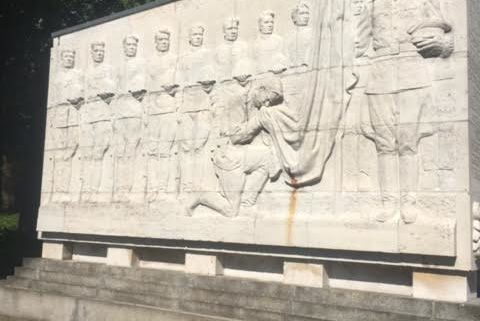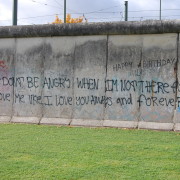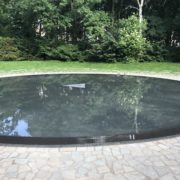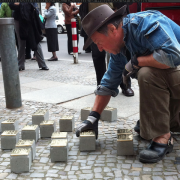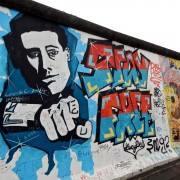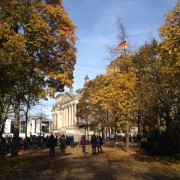The Soviet War Memorial
By Stella Van Ness
The Soviet War Memorial in Berlin, Germany was built in 1949 to commemorate those who fought in the Soviet army during the Second World War. I found that above all else the Soviet War Memorial is a symbol of power. The sheer scale of the memorial is enough to support this. When you enter you pass through a set of two massive walls that resemble gates. At the base of these gates are two soviet soldiers kneeling as a sign of respect to those who have passed. Once inside of the memorial there are sixteen stone sarcophagi lining either side. These sarcophagi tell the story of the war from the Soviet point of view. Each sarcophagus has two reliefs engraved on them, one on each side, and a quote from Josef Stalin narrating the story. The set of sarcophagi on the right is written in Russian, and the set on the left is written in German. The story leads you all the way to the back of the memorial where the main statue stands. The main statue stands 12 meters (39 feet) tall. But I feel as if numbers do not do this statue justice. It is far bigger than a person can imagine in their head, without seeing it for themselves.
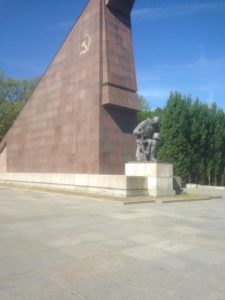 The most prominent representation of the Soviet’s power is the main statue. The statue depicts a man holing a sword and carrying a child on his back. The symbolism the Soviets used to create this statue is quite strong. The base the man stands on is a broken swastika that has been cut in half by the sword. By standing on top of the broken symbol the Soviets are conveying their defeat of the fascist German government. I think that the child on the man’s back could represent the new government that the Soviets are bringing into the world. The fact that the man is carrying the child shows how people would need to work together in order to make the new government work. I also think that the placement of the statue with in the memorial holds strong symbolism as well. Being at the back of the memorial makes him the end of the story. He is what the Soviets hope to become, a strong new power. I think that placing him high above everything else in the memorial is a way of displaying how the Soviets rose up to defeat their enemies.
The most prominent representation of the Soviet’s power is the main statue. The statue depicts a man holing a sword and carrying a child on his back. The symbolism the Soviets used to create this statue is quite strong. The base the man stands on is a broken swastika that has been cut in half by the sword. By standing on top of the broken symbol the Soviets are conveying their defeat of the fascist German government. I think that the child on the man’s back could represent the new government that the Soviets are bringing into the world. The fact that the man is carrying the child shows how people would need to work together in order to make the new government work. I also think that the placement of the statue with in the memorial holds strong symbolism as well. Being at the back of the memorial makes him the end of the story. He is what the Soviets hope to become, a strong new power. I think that placing him high above everything else in the memorial is a way of displaying how the Soviets rose up to defeat their enemies.
While it may be located on German soil the memorial is completely Soviet in nature. It is blatantly obvious that only the soldiers who fought for the USSR are being honored on this plot of land. On the inside of the gates is the hammer and sickle of the Soviet Union. The two kneeling men and the large standing one are all wearing soviet uniforms, and the primary language found in the memorial is Russian. I could not see any symbols to represent the Germans. I found this to be quite interesting, considering the fact that Berlin is the nation’s capital. I know that the city was spilt up in to subsections that were controlled by the Allies after the war, but I still find it odd that there is so little German to be found within the memorial. The memorial not only appears to be an extension of Soviet land on to German territory but also an extension of Soviet power. I think that this was very brazen of the Soviets. They disregarded the suffering that the German people must went through, and built a memorial to commemorate their defeat on their own land.
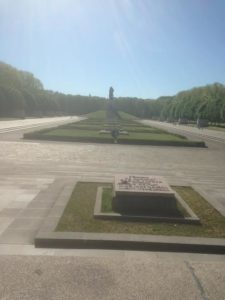 Walking through this memorial made me feel a sense of inferiority. The sheer scale of the memorial made me feel small in size, while the supremacy the stones gave off made me feel meek. I have a hard time believing that this is just a coincidence. I think that the Soviets wanted to give the Germans a permanent reminder of who came out on top after WWII had ended. It was the Soviets who rose up and helped to conquer the Germans. It was the Soviets who took over East Germany, and it was the Soviets who became a super power in the world when the war was over. I firmly believe that they wanted to install the inferiority I felt in any German who entered the memorial. I also felt sadness while looking at the pictures on the sides of the sarcophagi. While I cannot speak Russian or German, the pictures themselves allowed me to understand that this was the story of the war. I think that pictures also work as a way of creating a visual of how the Soviets suffered because of the Germans. This would give good reason for them to step in and create a new government for the people of East Germany. To me, this memorial felt more like a warning to the Germans than a county trying to pay respect to their dead.
Walking through this memorial made me feel a sense of inferiority. The sheer scale of the memorial made me feel small in size, while the supremacy the stones gave off made me feel meek. I have a hard time believing that this is just a coincidence. I think that the Soviets wanted to give the Germans a permanent reminder of who came out on top after WWII had ended. It was the Soviets who rose up and helped to conquer the Germans. It was the Soviets who took over East Germany, and it was the Soviets who became a super power in the world when the war was over. I firmly believe that they wanted to install the inferiority I felt in any German who entered the memorial. I also felt sadness while looking at the pictures on the sides of the sarcophagi. While I cannot speak Russian or German, the pictures themselves allowed me to understand that this was the story of the war. I think that pictures also work as a way of creating a visual of how the Soviets suffered because of the Germans. This would give good reason for them to step in and create a new government for the people of East Germany. To me, this memorial felt more like a warning to the Germans than a county trying to pay respect to their dead.

